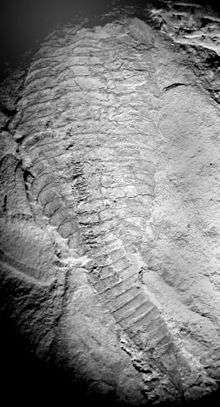Fuxianhuia
| Fuxianhuia protensa Temporal range: Lower Cambrian | |
|---|---|
 | |
| Scientific classification | |
| Kingdom: | Animalia |
| Phylum: | Arthropoda |
| Subphylum: | Chelicerata? |
| Class: | Yunnanata† |
| Order: | Fuxianhuiida |
| Family: | Fuxianhuiidae |
| Genus: | Fuxianhuia |
| Binomial name | |
| Fuxianhuia protensa Hou, 1987 | |
Fuxianhuia protensa is a Lower Cambrian fossil arthropod known from the Chengjiang fauna in China. Its purportedly primitive features have led to its playing a pivotal role in discussions about the euarthropod stem group. Nevertheless, despite being known from many specimens, disputes about its morphology, in particular its head appendages, have made it one of the most controversial of the Chengjiang taxa, and it has been discussed extensively in the context of the arthropod head problem.
The genus is named after Fuxian Lake (Fuxian Hu), where it was unearthed. Its specific name protensa refers to its extended trunk.[1]
Morphology
Complete Fuxianhuia specimens are approximately 4 centimetres long. The anterior of Fuxianhuia is encased in an oval sclerite, from which two stalked eyes emerge. Inserting directly behind this sclerite, on the head shield proper, are two stout antennae. When the head of Fuxianhuia was originally described, two additional head appendages, the "sub-chelate" pair were also described.[2] These are geniculate, backward-pointing appendages that lie in a highly stereotypical position (i.e., their position does not vary much from one specimen to another). Partly because of this, and partly because of their rather indistinct morphology, their status as appendages has been questioned. Indeed, on the grounds that these structures seem to lie between two cuticular layers, Waloszek and colleagues have suggested that they are not appendages at all, but rather gut diverticula;[3] a reassignment that has however not been universally accepted.[4] Ventrally, a large plate has been interpreted as a hypostome.
The head shield overlaps a tapering series of 12–17 trunk tergites, which lead into a set of limb-bearing segments comprising the thorax. The limbs are simple in form, consisting of a smooth oval exopod and a stout, annulated endopod. There is no one-to-one correspondence between the thoracic tergites and the limbs, but, rather, there appear to be two or three limbs per tergite.
Behind the thorax is a narrower abdominal region, consisting of 14 tergites, that bears no appendages. The abdomen is terminated by a telson-like spine.
Brain anatomy
In 2012, a Fuxianhuia fossil was described with exceptional preservation of brain and optic lobes.[5] The shape and complexity corresponds roughly to that of a modern malacostracan brain.[5] In general, the Fuxianhuia brain shows the same tripartite morphology of Malacostraca, Chilopoda and Insecta, indicating that such an organization could be precedent to the divergence between these clades.[5]
Cardiovascular anatomy
In 2014 a fossil was described in the journal Nature Communications that preserved in exquisite, unequaled detail the tubular heart and blood vessels, which represent the oldest cardiovascular system yet identified. "The rich vascularization in the head... suggests that the brain of this species required a good supply of oxygen for its performance," said University of Arizona neuroscientist Nicholas Strausfeld, one of the researchers.[6]
Classification
Fuxianhuia was first described from incomplete material,[7] and its true nature did not become apparent until the head and limbs were discovered. Its articulated head region, lack of tergite-segment correspondence and undifferentiated limbs have all been taken to indicate a very basal position in the arthropods,[2][8][9] even though an early cladistic analysis suggested, rather, that it was a stem-group chelicerate.[10] The presence of a distinct anterior sclerite bearing the eyes has been taken to suggest that a distinct acron once existed in front of the euarthropod head.[2]
Fuxianhuia is not a unique arthropod: two other taxa, Chengjiangocaris and Shankouia are clearly closely related,[3] although they differ in some details, such as the limbs. A relationship with the Burgess Shale taxon Canadaspis has also been suggested.[9]
Notes
- ↑ Dunham, Will. "Sea creature fossil found with oldest-known cardiovascular system". Reuters.
- 1 2 3 Chen, JY; Edgecombe, G. D.; Ramsköld, L.; Zhou, L (1995). "Head segmentation in Early Cambrian Fuxianhuia: implications for arthropod evolution". Science. 268 (5215): 1339–1343. doi:10.1126/science.268.5215.1339. PMID 17778981.
- 1 2 Waloszek, D.; Chen, J.; Maas, A.; Wang, X. (2005). "Early Cambrian arthropods – new insights into arthropod head and structural evolution". Arthropod Structure and Development. 34 (2): 189–205. doi:10.1016/j.asd.2005.01.005.
- ↑ Scholtz, G.; Edgecombe, G. D. (2006). "The evolution of arthropod heads: reconciling morphological, developmental and palaeontological evidence". Development, Genes and Evolution. 216 (7–8): 395–415. doi:10.1007/s00427-006-0085-4.
- 1 2 3 Ma, X.; Hou, X.; Edgecombe, G. D.; Strausfeld, N. J. (2012). "Complex brain and optic lobes in an early Cambrian arthropod". Nature. 490 (7419): 258–261. doi:10.1038/nature11495. PMID 23060195.
- ↑ Strausfeld, quoted in Will Dunham, "Sea creature fossil found with oldest-known cardiovascular system", Yahoo Bews, 7 April 2014: accessed 7 April 2014.
- ↑ Hou, X.-g (1987). "Three New Large Arthropods from Lower Cambrian, Chengjiang, Eastern Yunnan [In Chinese]". Acta Palaeontologica Sinica. 26: 272–285
- ↑ Hou; Bergström, J. (1997). "Arthropods of the Lower Cambrian Chengjiang fauna, southwest China". Fossils & Strata. 45: 1–116.
- 1 2 Budd, G. E. (2002). "A Palaeontological Solution to the Arthropod Head Problem". Nature. 417 (6886): 271–275. doi:10.1038/417271a. PMID 12015599
- ↑ Wills, M. A.; Edgecombe, G. D.; Ramsk ld, L. (1996). "Classification of the Arthropod". Science. 272 (5262): 746–747. doi:10.1126/science.272.5262.746
Further reading
- Hou, Xian-Guang; Aldridge, Richard J., Bengstrom, Jan; Siveter, David J.; Feng, Xiang-Hong 2004; The Cambrian Fossils of Chengjang, China, Blackwell Science Ltd, 233 pp.